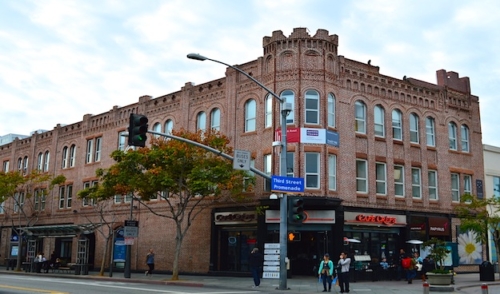Keller Block

- Known As
- Romanesque Revival
- Architect
- Carroll H. Brown
- Built
- 1893
- Designated
- October 13, 2008
This prominent building is a major landmark from Santa Monica’s early history, marking her prosperity and ambitions in the 1890s. As a three-story building, it was then the largest building downtown, and made Third Street the new commercial center. Just across the street to the east was an Opera House which opened in 1886, indicating the city’s cultural aspirations. The Keller Block housed shops, a corner drug store, and the Hotel Jackson upstairs. Henry W. Keller was the Vice-President of the Bank of Santa Monica.
Architecturally, it is a well-preserved example of Romanesque Revival – a style based on medieval European traditions as reinterpreted by Boston architect Henry Hobbs Richardson in the latter 1800’s. Arched windows, rough-cut stone (such as that used for the lintels and sills of the window surrounds) and masonry construction are typical of Romanesque Revival. The corner tower is also typical. Note the pattern of alternating header bricks used in the construction of the tower to turn the corner, creating a decorative feature.
The building retains much of its original design and materials. The portion along Broadway is divided into bays by engaged brick piers resting on corbels that spring from the string course running above the ground floor storefronts. The windows are paired inside the bays. The tall narrow proportions of the windows are typical of the Victorian era. Arches also are used for a doorway and window along Broadway. The arch motif is carried into the row of small arches (a blind arcade) at the parapet level. Decorative enrichment is created by the brick treatments, such as the quatrefoils in the parapet and the vertical shafts on the pilasters.
The parapet is stepped, and an ornamental elevated parapet is placed at the north corner. Some of the cast iron framing of the original storefronts may still be found on the Broadway façade; note at the base the inscription “Llewellyn Bro’s Los Angeles.” The cast iron contains decorative rosettes, floral accents and molded panels.
This building was renovated in 1988 as a pioneering project of the Bayside District Corporation for the Promenade’s revitalization. However, lack of knowledge at that time resulted in damage to the material fabric – the brick was sandblasted and the mortar repointed using an incompatible material which enlarged the mortar joints. The windows also are new and are not original – although the double-hung window type recalls the originals. Carroll H. Brown, the architect, also designed the Stimson House, another Romanesque Revival building that is a Los Angeles Historic-Cultural Monument.